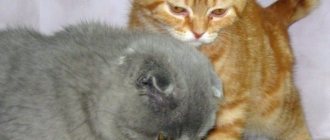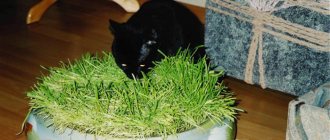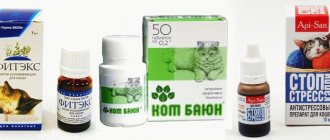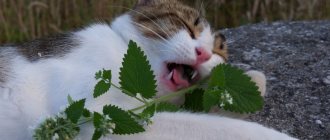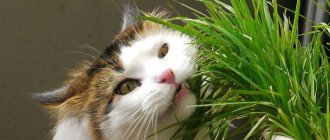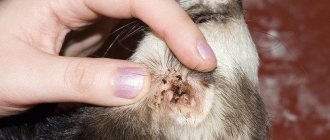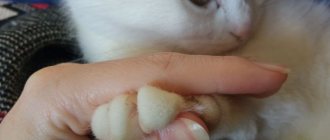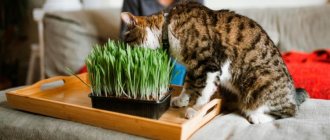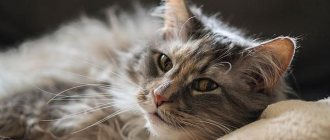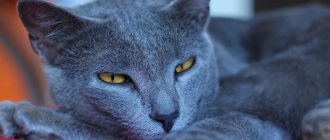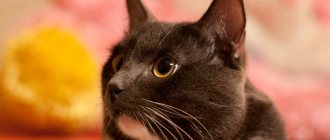Almost every cat naturally eats grass, but why do they do it? I'll be honest: people don't know why cats eat grass. There are many speculations, but there is no consensus on the real reason why almost all cats instinctively chew grass.
In this article, we will not understand why cats eat grass, we will talk about the types of herbs that cats love to eat, and which you can grow at home, in order to please your four-legged friend with them from time to time.
Grass for cats: why do they eat it?
The village cat, moving freely along the street at any time convenient for him, will find the necessary plants if necessary. City animals do not always walk in ecologically clean areas, and sometimes do not leave apartments at all. For owners of these animals, the question of whether to feed cats grass is the most pressing. Usually, when a pet appears in the house, it stops spoiling other house plants.
© shutterstock
Experts name different reasons why cats eat grass.:
- Induce vomiting . Scientists believe that animals do this instinctively after overeating. By nature, cats are predators. When hunting birds and rodents, it is necessary to clear the stomach of debris, feathers and hard-to-digest bones.
- Plant fiber helps improve digestion , remove parasites from the gastrointestinal tract, hair knots, etc.
- It has been proven that cats instinctively feel which plant helps with constipation and diarrhea.
- Another reason why cats eat grass is to replenish nutrients in the animal's body. Thus, the sprouts of cereals and legumes contain large amounts of folic acid, which is necessary for the production of hemoglobin.
- Felines love the aroma and fresh juice of a certain herb.
Cats crave mint and valerian
The amazing affection of cats of all types and breeds for valerian and catnip has always attracted the attention of people. These completely different plants contain special pheromones, which attract both pets and wild predators. Such cat passion can turn out both to the benefit of animals and to their detriment.
Cat mint
The very name of catnip (or catnip) indicates the special attitude of cats to this inconspicuous perennial grass, which grows everywhere like a weed: in meadows and parks, wastelands and vegetable gardens.
Catnip grows up to a meter in height, has jagged leaves characteristic of all types of mint and modest inflorescences of various shades - white, pink, purple. The peak of flowering occurs in mid-summer - during this period the grass is harvested, if necessary.
Catnip is usually harvested during the flowering period
The organic compound nepetolactone is the main component of the essential oil, which determines the attractiveness of the plant to adult cats. Immature kittens are not interested in this natural pheromone, but sterilized animals react to it differently, but most often in the same way as before the operation. Older animals become indifferent to the delights of catnip.
It is curious that this passionate attachment is genetic in cats and cats and is inherited. That is why there are some adult individuals who do not react at all to the “magical” smell of catnip.
By influencing those areas of the brain that are responsible for the emotional sphere, nepetolactone causes mild, but very pleasant hallucinations for the animal - obviously of an erotic nature. Cats do not develop any addiction, much less dependence on this substance, so catnip can be considered a safe plant for them. But prolonged exposure to nepetolactone in especially emotional people can lead to overexcitation and even disorders of the nervous system.
The effect of this herbal aphrodisiac is short-lived and usually lasts no longer than a quarter of an hour. Then it will take at least forty minutes before the cat becomes receptive to it again.
For most cats, catnip evokes pleasant visions.
Catnip can be used either fresh or dried, or as infusions; Pet stores sell ready-made preparations based on the extract of this herb. The properties of catnip are used for various purposes:
- improve appetite;
- trained to use the tray;
- switch attention from scratching wallpaper and furniture to the scratching post;
- processing new toys.
Interestingly, catnip essential oil is hated by some household pests and unwanted insects:
- rats;
- mice;
- cockroaches;
- mosquitoes
By the way, valerian officinalis and drugs based on it have the same properties.
Video: What a cat is willing to do to get catnip
Valerian
Valerian officinalis is popularly called cat herb - almost all adult cats react violently to this plant. The effects of pungent valerian on cats are similar to the effects of catnip on them - but in this case you need to be more attentive and careful. An overdose of the enzyme actinidin contained in the herb and especially the roots of valerian can lead to undesirable consequences.
Valerian officinalis is a tall herbaceous plant with carved leaves and umbrella-shaped inflorescences.
This beautiful perennial plant reaches a height of one and a half meters. It blooms with spectacular white “umbrellas” almost throughout the warm season. All parts of the plant can be harvested, but its roots contain the highest concentration of active substances.
The plant substance is identical to one of the odorous components of cat urine and acts on adult cats as a powerful aphrodisiac, changing for a short time not only their emotional but also hormonal balance. This can pose a serious danger to the animal and cause the following unpleasant side effects:
- convulsions;
- strong secretion of saliva and foam from the mouth;
- clouding of consciousness;
- difficulty breathing, even stopping;
- stroke.
A cat that has tasted valerian or catnip may behave inappropriately
Actinidin has an exciting effect on cats - they behave as if they are in a state of drug intoxication and get great pleasure from it. But this creates a huge load on the nervous system, and if it is unstable, then you should not abuse valerian under any circumstances - it is definitely not fun.
Don't give valerian to your cat just for fun.
The valerian plant is unlikely to cause harm to your pet, but medications that contain concentrated actinidin can become a source of danger for the cat. There are strict contraindications for the use of alcoholic extracts of valerian:
- increased excitability;
- kidney and liver pathologies;
- periods of pregnancy and lactation.
Valerian is dangerous for a pregnant cat
But valerian in moderate doses is very useful for digestion. The fact is that this herbal medicine also has the property of relaxing smooth muscles, which helps relieve spasms and colic in the gastrointestinal tract. Veterinarians also prescribe valerian preparations in the complex treatment of cardiovascular diseases and thyroid problems. You must strictly adhere to the doctor's recommendations and dosage of medications.
Scientists studying the life of wild cats in nature often use valerian tincture to lure the animals closer.
Some other plants can have an effect similar to valerian and catnip on representatives of the cat family:
- peppermint;
- thyme;
- lemongrass;
- Melissa;
- honeysuckle.
Video: cat eats dried valerian
What grass do cats eat?
- Green oats, wheat and barley are the most common grasses that experts typically recommend growing or purchasing for cats. Rich in folic acid and vitamin B, which improve the quality of animal fur. However, there are other safe plants that these animals love.
- Lemongrass . A natural antiseptic that improves digestion and has a diuretic effect.
- Melissa . Many cats simply adore this plant, so to avoid stomach upset in pets, the container with vegetables should be removed from time to time. The aroma of the plant lifts the mood of cats, they become playful. The same can be said about mint.
- Thyme helps the digestive tract. Recommended for overweight cats, as it optimizes metabolism in the body.
- Carrots contain large amounts of selenium, a powerful antioxidant that protects cells. You can grow vegetables from vegetable scraps, but you don't have to mess with them. Large amounts of selenium in cats cause hair loss, anemia and other signs of intoxication with this trace element.
- Parsley . If your cat likes the grass of this beneficial plant, great! Fresh green vegetables are rich in fiber, potassium and vitamins including ascorbic acid, A and B.
Not all plants that your pet may like are listed here. Cats are loyal to violets and rosemary, catnip and valerian. They happily chew on chlorophytum. After observing the animals, the owner can independently determine which plants his pet likes.
© shutterstock
Dangerous plants according to the degree of impact on the body of cats
Plants that contain toxins that cause nausea and vomiting: arum, belladonna, datura, sweet tobacco, petunia, tansy, celandine, potato shoots, eggplant, tomatoes and other nightshades. This effect is caused by the high content of alkaloids, glycosides and organic acids, which are extremely dangerous for cats. Drowsiness, cramps, increased salivation and diarrhea may occur.
Swelling of the larynx, burns of the oral mucosa and the entire esophagus can occur if a cat eats shoots or leaves of begonia, trifoliate arizema, azalea, oriental thuja, honeysuckle, dogwood, tobacco or maiden grapes. Often these plants cause impaired coordination of movements and acute heart failure.
Diarrhea and vomiting in cats occurs when eating castor beans, wisteria, crocuses, clematis, laconosa, American lysichiton, ferns, rhododendron and yew berry.
Heart and kidney failure can be caused by mistletoe, black locust, spring white flower, hydrangea, delphinium, horse chestnut, foxglove, orange tree, physalis, hellebore.
Symptoms after eating these plants can also manifest themselves in the form of vomiting, diarrhea, cramps, and difficulty breathing. In some cases, this can result in death for the cat.
Particular attention should be paid to hellebore , as some pet owners still treat their cats for fleas with hellebore water from the pharmacy. Unfortunately, such treatments have killed more than one cat, because the toxins contained in the plant are poisonous not only for parasites, but also for the animal itself.
Nowadays, there are many harmless drugs for treating cats against ectoparasites, so you should not use such dangerous methods that risk the life of your pet.
Aconite (fighter), henbane, wolf's bast, gloriosa, jasmine, lupine, buttercup, oleander, rhubarb, and evergreen boxwood have a systemic toxic effect, including death
Common causes of allergic dermatitis are all primroses or primroses, chlorophytum, autumn colchicum, spurge, and spring whiteflower. Primroses cause skin burns along with hogweed and fragrant rue.
How to grow grass for cats
If you go to a pet store or flower shop to buy catnip, you will most likely be offered ready-made sprouts or seeds of young oats. It is very easy to grow yourself at home; this herb is unpretentious and harmless, which is why it is so popular in specialized retail outlets.
You need to buy clean soil for planting at a flower shop, and not dig it somewhere on the street. Then cover the seeds in a small container with a layer of 1.5-2 cm, pour them out and place them under the film. After the germs appear, let the cat grow up without covering it with film. From the sixth day after sowing oats, the animal will be able to enjoy the young shoots of vitamins.
"Vegetable garden" for a cat
Some caring owners regularly collect fresh grass for their pets on the street and even dry it for the winter. But the benefits of such care are very doubtful. If you are not completely sure that a vitamin supplement will be harmless for your pets, it is better to grow the greens yourself, especially since it is absolutely not difficult.
Cat grass should only be collected in clean and safe places.
What grass to grow
At home, the easiest way to germinate grains of cereal plants is: wheat, oats and barley - they are distinguished by good germination and rapid development, and cats really like their juicy sprouts.
Cereal seeds are good for growing cat grass
There are a lot of useful substances in such greens, and there will definitely be no harm from them - but only if you are guaranteed to purchase seeds that have not been treated with pesticides to protect them from rodents. To play it safe, buy planting material from pet stores.
Carrot tops grown on a windowsill are a storehouse of vitamins for your cat
Of course, you can experiment and proceed from your pet’s preferences - offer him sprouts of various plants, thereby enriching the cat’s diet. But this requires certain knowledge and experience in order to choose the right “bouquet” of herbs and get a good harvest of greens.
Video: the cat chooses its own weed
Growing methods
There are a lot of nuances to growing grass for cats, as well as devices that make this already simple process easier. Let's look at the simplest, most basic method using the example of germinating ordinary wheat. The acquired skills can be confidently applied to any other seeds in order to sprout useful grass from them.
To begin with, of course, you need to choose fresh and high-quality seeds. When purchasing them in a store, pay attention to the terms and conditions of storage. If you buy wheat grains, for example, at the market, choose only whole, fresh and shiny ones - the seeds should not be crushed, damaged by pests or mold.
You can only germinate healthy and untreated wheat.
Now you can get to the fun part - turning dormant grains into living grass:
- Dry the wheat thoroughly and pour it into a glass jar with a tight-fitting lid - from here it will be convenient to take the right amount of seeds each time.
- Take a handful of beans - enough for one serving - and rinse them thoroughly with tap water.
- Spread the wet, clean grains in an even layer over the bottom of a wide, shallow bowl - it can be glass, ceramic or enamel.
- Pour unboiled water at room temperature into a bowl so that it completely covers the seeds, and leave them to swell in a warm place for two days.
- After two days, the seeds will increase in volume and small white seedlings will hatch from them - wheat can be planted.
- Rinse the sprouted grains with running water again - in our case we will plant them in the soil; Universal soil is suitable for indoor plants.
- For a mini-cat lawn, it is most convenient to take two disposable plastic bowls - in one the wheat will grow, and the second will serve as a tray where excess water will drain.
- In the bottom of the first bowl, punch several small holes for water drainage and add soil - two to three centimeters deep will be enough.
- Scatter the sprouted grains evenly over the surface of the soil and lightly sprinkle the soil on top.
- Place one bowl in another, pour plenty of water over the “crops”, cover this structure with a transparent plastic bag and place it in a bright, warm place - on the windowsill.
- In three days, when friendly shoots appear above the ground, the package can be removed - the grass lawn for the cat is ready.
The sprouts will reach full condition in another three to four days - the green treat can already be offered to the cat. This portion will last her for about a month. And all this time you will need to ensure that the soil remains sufficiently moist and the grass roots do not rot. Don’t forget to take care of the germination of the next “series” of weed in a timely manner.
This is what sprouted grass looks like on the 4th and 8th days
In a similar way, you can grow grass without soil - simply on a layer of wet cotton wool, in sawdust, or even... in wood filler for a tray. Just make sure that the cat does not use the litter for its intended purpose. But we must admit that in the soil, greens still grow faster and better, last longer and are more abundantly saturated with substances beneficial to the cat.
Some manufacturers offer these cute bowls in kits for growing herbs
To minimize effort, you can purchase a grass growing kit online or at a regular pet store. It is inexpensive, looks aesthetically pleasing and greatly simplifies the process. There are even, for example, mobile stations for germination, equipped with special massage mats for cat paws, and other original and pleasant little things.
Video: growing grass for a cat on the windowsill
Which seeds to choose
The pet industry takes into account the need of cats for fresh grass and the ever-growing demand in this area. Therefore, the range of seeds and kits for growing cat grass is increasing and becoming more diverse. We invite you to compare offers from several popular brands before making your choice.
Table: overview of herbal offerings for cats from various brands
| Trade marks | Type of grass | Method and time of cultivation | Estimated cost |
| "Horse" | herbal mixture:
| seeds are germinated in any way convenient for you in one and a half to two weeks | 13 rubles for 10 grams |
| "Chica" | oats | can be grown both in soil and without it - on a wet napkin; germination time - up to 10 days | 70 rubles for 300 grams |
| "Alpine Meadows" | a mixture of seven plant seeds:
| herbs in a vermiculite-based substrate and a convenient container grow in an average of 10 days | 80 rubles per 100 grams |
| "Aelita" | barley | grown in containers with any soil for about 8 days | 17 rubles for 20 grams |
| "Sedge" | cereal mixture | offered complete with nutrient substrate and tray; Germinates up to 10 days | 60 rubles for 30 grams |
| Trixie | barley or mixture with clover (for demanding cats and kittens) | mixtures of seeds and substrate in a ceramic bowl are germinated until ready in 5–6 days | 120 rubles for 50 grams |
| TitBit | oats | without soil - in a container and padding polyester bag - ready for use in 8 days | 60 rubles for 40 grams |
“Ready” plants for cats
In cases where the owners are especially lazy or the cat needs greens very urgently, there is also a way out. You can buy weed in the store that is already completely ready for your cat to eat. This is very convenient, and according to sellers who know the market situation, the demand for such relatively new products is growing.
Plants - mostly the same cereals or mixtures thereof - are offered in pots or trays of various sizes. The optimal dimensions of the tray for one cat are 20x20 centimeters. The grass is grown in soil or a special nutrient gel, which is harmless to the cat if it suddenly decides to eat it.
Ready-made grass in a tray is very convenient
But manufacturers still recommend not feeding grains and roots to pets, but to do this, keep the tray somewhere out of reach. Cut the grass as needed and add it to the cat's food bowl. However, many owners do not play it safe and give their pet the opportunity to feast on greens as much as he wants. Among other things, such an innovation is a real salvation for indoor plants.
Such beauty in a tray costs about 150 rubles. But you can buy the same portion of herbs for three times cheaper - sellers will simply “plant” the required amount of greens in a bag for you, and at home you will already move it into a beautiful pot or any other container of your choice.
Which herb do you prefer?
- It is difficult to say for sure which greens will appeal to which pet. To do this, the animal should be released for a walk to evaluate its preferences. Experience shows that most furry friends prefer weeds, such as wheatgrass. This is a fairly tough plant that grows almost everywhere along with grass.
- As a rule, he gets most of the unoccupied space of the land. The downside is that the weed is dirty, it concentrates harmful microorganisms and toxins from exhaust gases, helminth eggs, as well as chemicals, etc.
- Of course, you can collect the grass and give it a thorough treatment, but there will be no confusion. But it is impossible to extract all these toxic compounds that have accumulated for a long time from the plant. As a result, this weed disappears. Moreover, fully domesticated animals themselves do not know what they want. Some of them may even attack the broom in hopes of a feast. Therefore, the choice remains with the owner.
- On the other hand, even indoor vegetation concentrates a certain amount of harmful substances, so it is also not suitable for the cat family. Hence the need to personally grow the right herb. This is done in order not to damage the animal’s digestive tract and transfer only valuable substances to the body.
- Some cats take great pleasure in eating dry greens. Therefore, at the slightest opportunity in summer, vegetation should be collected immediately. Once the grass is harvested, it is washed, removes moisture, and collects the honeycomb. They are then hung and dried in the pantry or on the balcony. Don't worry that such an animal won't do this. On the contrary, he will like it. The main thing to remember is that the collection is carried out away from highways and smoky places. The ideal option is a village.
Growing methods
The grass can be found in ready-made form at a pet store, or you can simply pick it on the street. But if you still decide to sow and grow a tasty and healthy treat for your pet yourself, then let’s look at several planting options.
Option #1
Planting grass in soil or vermiculite.
This method is perfect for those who have large space on window sills and balconies. To begin with, you will need an oblong container for soil, or an ordinary pot. You can buy ready-made soil at a pet store or veterinary store, the main thing is to make sure that it is not oversaturated with various additives and minerals. The pot for germinating grain crops must have a drainage system (small holes at the bottom of the container). This will ensure oxygen saturation. To drain excess moisture, a stand is needed.
Landing algorithm:
- Soak the seeds in water for 40-60 minutes;
- Fill the container with soil to about halfway;
- Water the soil thoroughly;
- Place the soaked seeds so that they cover the entire space. This will ensure a dense harvest, even if some sprouted seeds do not sprout;
- Cover the seeds with 0.5-1 cm of soil;
- Be sure to cover the ground with cling film or polyethylene. This will provide a greenhouse effect and help the seeds germinate faster.
- As soon as the first shoots appear 2-3 cm from the ground, you can remove the film;
- Growing time is 10-15 days.
Germinating seeds in the ground
Option No. 2
Growing grass without soil.
The method of growing grass in an artificial environment without soil is called hydroponics. This planting option is very convenient for use at home - it will protect you from soil scattered around the apartment.
In this method, we also need a container for planting, as well as gauze, cotton wool, and polyethylene.
Landing algorithm:
- Take a container, cover the bottom with cotton wool, approximately 3-5 cm;
- Water the cotton wool generously;
- Cover the top with gauze; if there is no gauze, you can use a bandage:
- Pour the grains in random order;
- Cover the seed with film;
- Do not open the film at first so that moisture does not evaporate;
- The first white sprouts will appear on the 5th day; during this period you can sometimes remove the film to water the sprouts;
- We finally remove the film when the green sprouts are 2-3 cm from the ground.
Germinating seeds in cotton wool and gauze
Mr. Cat recommends: what to do if your cat likes to eat grass?
You should not interfere with your pet’s desire to chew vegetation. Of course, it is necessary to remove indoor flowers from the access zone; many of them can be poisonous and dangerous for the cat.
Instead, you can purchase special mixtures for germination or ready-made pots of herbs in the store. Most often, cereal sprouts are used as vitamin treats: barley, oats, wheat. You need to understand that cats' tastes may differ.
Some pets prefer to chew on a piece of cucumber or fresh pumpkin seeds. It is important to offer your animal several different options.
What indoor flowers can spoil?
Cat people often complain that their pets spoil their indoor flowers. The interest is not always gastronomic. They play with stems, dig in the soil, and turn over pots. Indoor flowers serve as a substitute for grass in winter. They are not always useful, often even poisonous. Cats will not touch flowers if greens are grown for them at home. This is especially important in the city, where the necessary plants cannot be found in the yard.
Ways to preserve indoor flowers:
- place in a place inaccessible to the pet;
- regularly spray with a solution of lemon juice, table vinegar or special sprays;
- place sprouted cereal next to it;
- cover the soil in pots with shells, pebbles, gravel;
- saturate the mulch with an unpleasant odor, cover with a plastic mesh;
- buy special grilles.
These measures will not help completely prevent damage to ornamental plants, but the risk will be reduced.
Following some simple rules also helps:
- plant flowers in hanging pots, on the walls;
- choose heavy containers;
- do not place plants on the windowsill too closely, use stands;
- secure racks and racks.
Ornamental plants can be protected with fences and display cases can be used.
What else can you grow?
Cats love plants as well as grass, and they may appear in your cat garden at home. They will not harm the animal, although you need to keep your pet's appetite under control.
This is how you can grow:
- Schisandra – cats like its smell, and the plant itself is healthy to eat. Schisandra is a natural antiseptic, antibiotic and sedative in one bottle, and also helps the animal’s digestion. The plant will switch the cat's attention from other indoor flowers to itself.
- Melissa is also liked by cats, but it must be eaten in strictly dosed quantities, otherwise the animal will face digestive problems.
- Parsley is a curly green that many furry foodies love. It is both tasty and healthy, as it contains many microelements and generally has a positive effect on the cat’s body.
You can also grow cereal crops at home - wheat, oats, rye.
